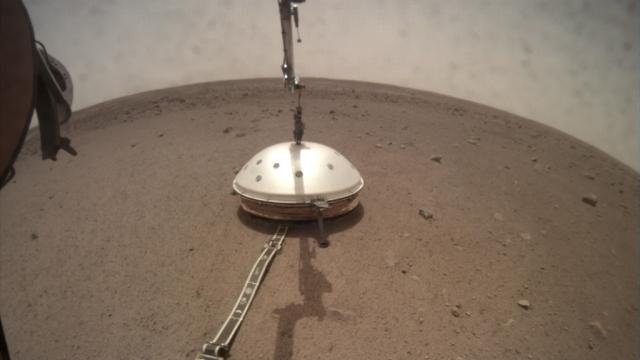Using its ultra-sensitive seismometer, NASA’s InSight lander has waited patiently to detect its first marsquake. Scientists now have good reason to believe it finally happened.
On 19 December 2018, the InSight lander successfully deployed its Seismic Experiment for Interior Structure (SEIS) instrument, followed by the placement of the seismometer’s protective dome in early February 2019.
The device began its monitoring duties a short time later — and it now appears to have detected a marsquake, according to a NASA press release.
The event in question happened on 6 April 2019. NASA is still looking at the data to figure out the exact cause of the apparent rumbling. If confirmed, however, it would be the first geologically induced tremor ever detected on another planet (as opposed to a tremor caused by a meteorite strike or high winds).
“We’ve been waiting months for a signal like this,” said SEIS team lead Philippe Lognonné in the press release. “It’s so exciting to finally have proof that Mars is still seismically active. We’re looking forward to sharing detailed results once we’ve had a chance to analyse them.”
The apparent marsquake featured a strength and duration reminiscent of moonquakes detected during the Apollo missions.
To be clear, however, this event was exceptionally weak, and not the kind of tremor that would send objects tumbling off shelves if it were to happen on Earth. As the NASA press release noted, an “event of this size in Southern California would be lost among dozens of tiny crackles that occur every day”.
Events of this nature work a bit differently on the Red Planet than on Earth. On our planet, earthquakes happen along faults, the result of shifting tectonic plates. Mars, on the other hand, is largely devoid of plates, but quakes still happen.
Cycles of cooling and contracting create internal stresses that are strong enough to rupture the crust, generating marsquakes. By detecting and studying these tremors, scientists are hoping to learn more about the Martian interior, and how rocky planets formed.
“We’ve been collecting background noise up until now,” said InSight principal investigator Bruce Banerdt in the press release. “But this first event officially kicks off a new field: Martian seismology!”
The SEIS instrument also picked up anomalous events on March 14, April 10 and April 11, but they were much weaker. The origin of these events remains unclear, and NASA is continuing to investigate.
This apparent detection of a marsquake is very exciting and very encouraging. It’s good to see the SEIS instrument do what it’s supposed to do, especially given the lack of success with InSight’s drill, which appears to have gotten stuck on a rock.
